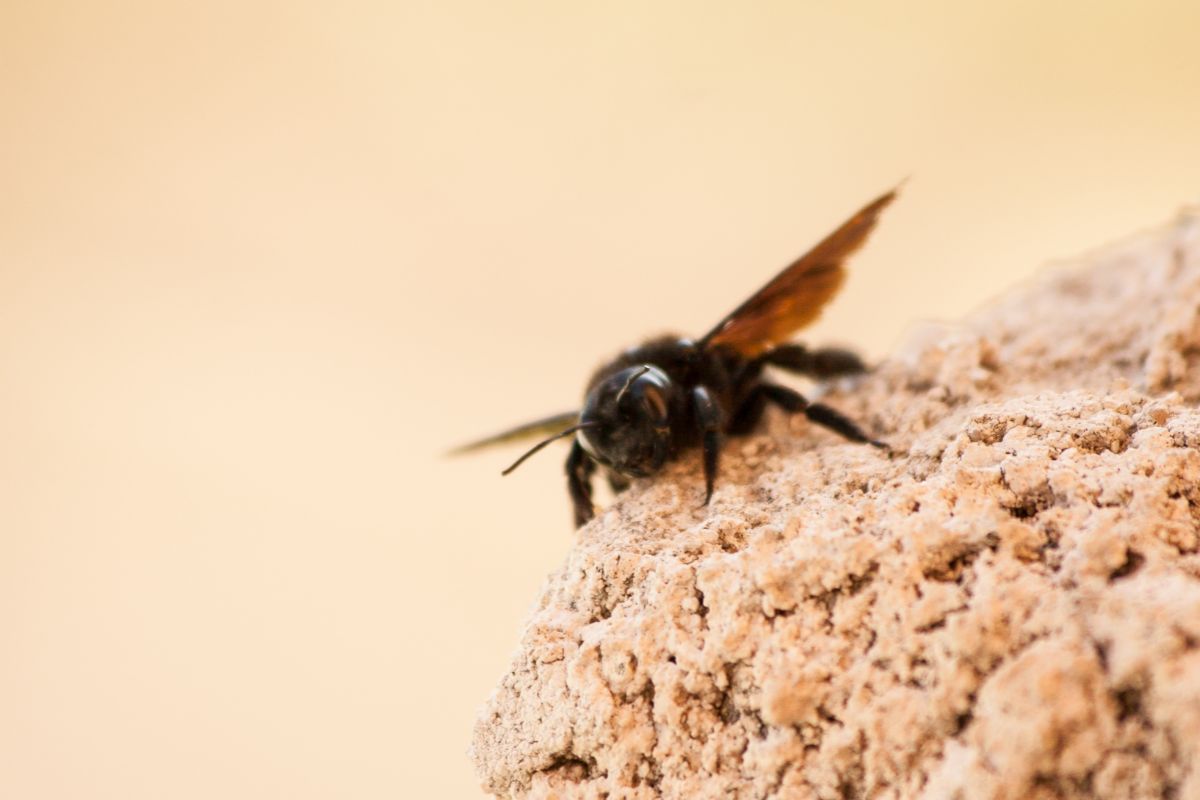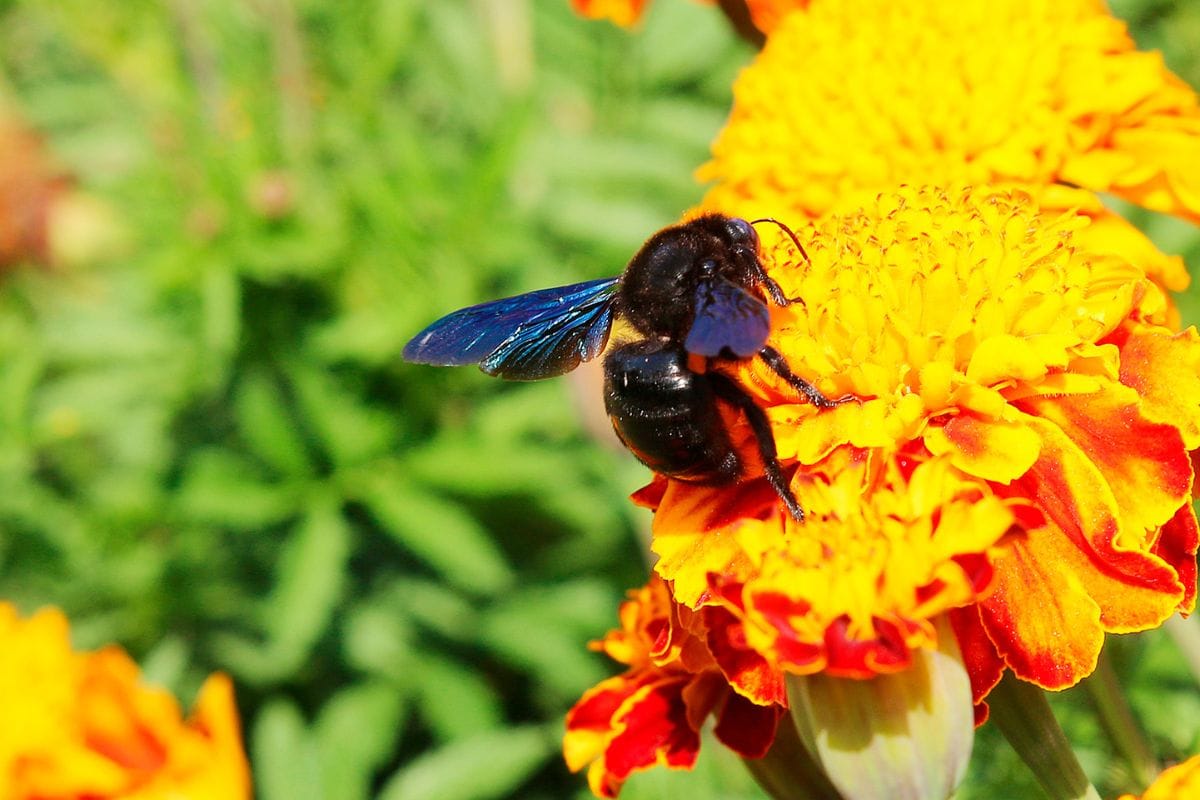Bees are the lifeblood of the entire ecosystem. They are responsible for pollinating as well as making honey.

From a distance, all bees might look the same, but you might already be aware that there are thousands of different species of bees, two of those being the honeybee and the carpenter bee.
If you put these two under a microscope, you’ll be able to notice some of the differences right away. They have a distinctive type of look: one has larger wings than the other, one has a darker body and another comes with a more pronounced tail.
So, what is the difference between the honey bee vs. the carpenter bee? Do they eat the same thing?
How does each one of them mate? How does each one behave?
Well, we’re going to take a deep dive into the world of each of these bees to see how they differ and how they are the same, and, most importantly, how you can better spot them in the wild.
Carpenter Bees Vs. Honey Bees – How The Two Shape Up
Now we’re going to weigh these two up, looking at their appearance, how they compare in terms and size, and what the span of their wings is.
One of the notable things about the honey-bee is that they live in large hives and are much more social creatures. The carpenter bee on the other hand is much more isolated and tends to congregate in much smaller families.
How They Look
The appearance of honeybees is very typical, especially from a distance. They are usually fat and squat and have yellow and brown stripes running across their body.
You can get some bees that are covered in fuzz and some bees that are slightly less hairy.
The honeybee is around 5/8 of an inch in length, whereas the carpenter bees are often much larger at around 1 inch in total length.
These bees also have a large black abdominal segment that doesn’t really have any hair on it. This is quite the distinction from the honey bee, which comes with yellow and brown fur all over this part of its body.
There are various species of carpenter bees that have different thoraxes, whether it be yellow, brown, white, black, or even blue. If you have a magnifying glass, then take a closer look to see which one you are inspecting.
How They Behave
Honeybees are very docile in nature, with the Caucasian and Buckfast breeds being far less aggressive than some of the other species, such as the Africanized bees, which can be extremely aggressive.
These types of bees will often pick fights with insects much larger than themselves.
The female honeybee is quite lethal and has a barb in her tail that will use if she feels threatened by anything. However, the sting will not detach, so the chances are that she will be crushed by whatever animal she is stinging afterward.
The female carpenter bee, much like the female honeybee, has a sting in her tail, except her sting she can use multiple times, making her far more deadly. Carpenters are also a lot bigger and they don’t really get attacked by many predators.
This leaves the carpenter bee free to build a nest and forage for food.
Male carpenter bees tend to behave as if they are attacking but they often won’t act upon it. They do not have a stinger, so they will not offer any real threat and leave a lot of the actual attacking up to the female.
Different Bee Colonies
These honeybee colonies often grow to larger sizes in response to different weather conditions.
When they are getting ready for the winter, the foraging will increase along with the workers in the colony, which will often balloon to a whopping 60,000 bees in total.
The fact is that the more bees there are, the more they can huddle together for warmth and get through the winter months.
A queen honeybee (see also: What Is A Honeybee Queen?)can lay around a thousand eggs in one day.
Other females will basically act as nurses and will help to rear the young through the harsher winter months. This is done until the younger bees can leave the nest and forage for themselves.
Carpenter bees are very different, being far more solitary, they do not construct large hives. Instead, they live in compact family units, usually in knot holes in trees.
Mother gives birth to a daughter, who usually stays within the perimeter of the nest.
The Nest
The nests of the honeybee and the carpenter bees are very different. The honeybees have female workers that are responsible for building hives from scratch, with the queen often monitoring the whole process.
Honeybees can dwell in the same hive for years if there is enough food and construction material in the general area.
When the nest of the honeybee gets too large and overcrowding is an issue, then the whole hive will swarm to find another nest, including the queen bee.
The carpenter bee’s method of homemaking is vastly different from honeybees.
They often will bore their way into the wood of a tree, using their mandibles to vibrate as fast as possible until they have made a completely spherical tunnel.
The nest of the carpenter bee usually has just one entrance to avoid any predators getting to the delicate eggs inside. There are chambers inside the carpenter bee hive, with storage space for each one of them and a place where the eggs are laid.
Honeybees will start to create honey in their hive to get it through the winter (see also: Ultimate Guide To Winterizing Your Hives)seasons. The carpenter bee, however, will not make any honey, rather they will hibernate with individual stores of pollen and nectar for the few months ahead.
How They Pollinate
When it comes to pollination, honeybees are no slouches.
They come in large numbers, which enables them to produce large quantities of the stuff. They have sacks on their hind legs in which they store the pollen to take it back to the hive.
Pollination is an essential part of how trees, plants and other vegetables in the area thrive.
This is why it is so important to have honeybee hives. They are basically like traveling pollination factories that go from one place to another.
Even though carpenter bees travel in smaller numbers, they still pollinate very well. They get the pollen from the flower in a very interesting way. They vibrate their antlers to the point where the pollen is shaken entirely off the flower.
In much the same way as the honeybee, the carpenter is essential for helping to grow vegetables such as tomatoes, eggplants, and various other local flowers.
How Do They Life And Die?
In the case of the honey bee, there are thousands of eggs laid by the queen every day. These eggs are laid in the brood comb cell and they are tended to by both the female workers, the nurses, and the queen bee herself.

The eggs hatch and become a pupa first, followed by a larva. It can take anywhere between 15-24 days to completely emerge from the cell as a bee.
A honeybee will often only live for around 6 weeks, although they can live for around 6 months during the colder weather when they hibernate.
The queen will live up to 6 months until she is no longer able to lay eggs, upon which point she dies and is replaced by a completely new queen.
Carpenter bees, on the other hand, are very different from worker bees. They do not have a queen, instead, the female carpenter bee will drill a hole into the wood and lay her eggs there.
When the egg is laid, a small lump of pollen is deposited along with it, which it can feed on when it hatches. The egg will become enclosed for around 6 weeks before it hatches from its cell.
They will usually emerge as fully formed adult carpenter bees.
Female carpenter bees usually live longer than males, usually around up to 3 years. They will lay very few eggs during their lifetimes, usually somewhere between 6 and 8.
The male drones will only live around 1 year and will die as soon as they have mated.
How To Remove These Bees
Sometimes you might encounter a swarm of honeybees fused to a part of your home. Often, they are taking some respite in between traveling from their old hive to a new one and will move within the day.
It is important not to interfere with these bees when they are swarming, as they could sting you multiple times, which could even be fatal. You can either leave them or call a beekeeper expert who will come out and transfer the bees safely to a new hive.
As we have mentioned above, carpenter bees usually nest in much more solitary places and do not form large hives. However, when they bore through wood, then this can lead to damage to people’s homes.
The only way to stop carpenter bees from drilling into your home is to spray every surface area with citrus.
Are Honeybees And Carpenter Bees Compatible?
The carpenter bee is quite a docile creature, so it will not attack any other bees. You can quite often see carpenter bees mingling happily alongside honeybees, as they will not provoke or try and steal their stores of honey.
Honeybees can be aggressive but because the carpenter bee is much larger than them, they will often steer clear. However, the Africanized version of this bee will often attack anything that approaches the hive.
Carpenter Bees Vs. Honeybees – The Final Breakdown
The Honeybee
- Color – Largely yellow and brown with slight gradients depending on the species.
- Size – 5/8 of an inch.
- Personality – Passive but can become hostile when provoked.
- Sting – a venomous sting that kills the bee after use.
- Colony size – 60,000 bees in one hive.
- Nest – Large hive made from beeswax.
- Pollination – they will collect pollen.
- Food – Royal jelly, honey, wax.
Carpenter Bee
- Color – Largely shiny and black but with yellow, brown and blue on the thorax.
- Size – 1 inch.
- Personality – Friendly females but aggressive males.
- Sting – Males have no sting, and females have a reusable sting.
- Colony size – usually dwell in smaller families.
- Nest – Tunnel into wood to create cells for their young.
- Pollination – vibrates pollen from flowers.
- Food – they do not create any harvestable products.
Conclusion
We hope that our guide to the honeybee and the carpenter bee has helped you to understand the subtle differences between the two and will help you to pick them out in the wild.
These bees are very distinctive and wonderful to watch from a distance.
- Does Bleach Kill Bees? - April 23, 2024
- How Do I Get Rid of Ants Without Harming Bees? - April 16, 2024
- Do Bug Zappers Kill Bees? Completely Explained - April 9, 2024
